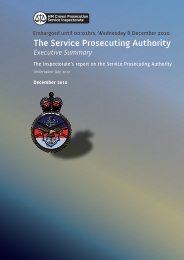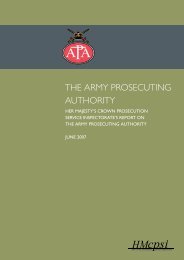Actions speak louder: A second review of healthcare in ... - HMCPSI
Actions speak louder: A second review of healthcare in ... - HMCPSI
Actions speak louder: A second review of healthcare in ... - HMCPSI
You also want an ePaper? Increase the reach of your titles
YUMPU automatically turns print PDFs into web optimized ePapers that Google loves.
ACTIONS SPEAK LOUDER<br />
FINDINGS<br />
Good practice from <strong>in</strong>spection reports<br />
“Children and young people who were referred to the youth <strong>of</strong>fend<strong>in</strong>g<br />
service were screened for their health needs as part <strong>of</strong> the Onset<br />
assessment and referred to specialist workers where appropriate.”<br />
“All children and young people at risk <strong>of</strong> <strong>of</strong>fend<strong>in</strong>g who were referred to<br />
both the youth <strong>in</strong>clusion programme (YIP) 16 and youth <strong>in</strong>clusion and<br />
support panels (YISP) had full access to the mental health and physical<br />
health screen<strong>in</strong>g and advice available through the youth <strong>of</strong>fend<strong>in</strong>g<br />
service. This <strong>in</strong>cluded a full-time drugs advisor and mental health and<br />
health workers provided by CAMHS and the primary care trust.”<br />
“Holistic health assessments regularly resulted <strong>in</strong> access to teenage<br />
pregnancy services, condom distribution by the YOT, smok<strong>in</strong>g<br />
cessation, parent<strong>in</strong>g support, priority GP and dental access and<br />
diabetes recognition. In addition, domestic violence, epilepsy,<br />
nutritional needs, bereavement counsell<strong>in</strong>g, public health issues,<br />
bully<strong>in</strong>g, anger management and immunisation were also addressed.”<br />
Too <strong>of</strong>ten, however, YOTs missed children or young people’s health issues because<br />
they did not make good <strong>in</strong>itial assessments. A quarter <strong>of</strong> <strong>in</strong>itial assessments (us<strong>in</strong>g<br />
Onset) <strong>in</strong> cases exam<strong>in</strong>ed were not judged by <strong>in</strong>spectors to have been <strong>of</strong> sufficient<br />
quality <strong>in</strong> relation to identified health issues. This expla<strong>in</strong>s why a similar percentage<br />
was judged not to have full attention paid to the methods likely to be most effective<br />
with the child or young person. A third <strong>of</strong> cases did not actively assess, at an early<br />
stage, diversity issues, factors that could discrim<strong>in</strong>ate aga<strong>in</strong>st or disadvantage<br />
young people, or other <strong>in</strong>dividual needs. Even where YOTs were mak<strong>in</strong>g accurate<br />
assessments <strong>of</strong> the range <strong>of</strong> health needs, there <strong>of</strong>ten rema<strong>in</strong>ed a shortfall <strong>in</strong> the<br />
cases <strong>of</strong> children or young people who were then appropriately referred for<br />
specialist assessment.<br />
Clearly, without a thorough and accurate assessment <strong>of</strong> needs, proper consideration<br />
<strong>of</strong> the capacity <strong>of</strong> health services to meet needs cannot be undertaken. Where health<br />
resources were low, or even non-existent, for preventative services with<strong>in</strong> a YOT,<br />
it created a ‘no-w<strong>in</strong>’ situation. Practitioners did not assess health needs, s<strong>in</strong>ce a<br />
service couldn’t be provided and health services <strong>in</strong>dicated that no clear need was<br />
apparent, due to the lack <strong>of</strong> referrals. Consequently, direct services were not<br />
provided.<br />
Good and productive work <strong>in</strong> prevention is key to deterr<strong>in</strong>g children and young<br />
people from <strong>of</strong>fend<strong>in</strong>g, and health services need to do as much as they can to assist<br />
16<br />
The Youth Justice Board’s evaluation <strong>of</strong> youth <strong>in</strong>clusion programmes revealed that 25,000 young people had<br />
benefited from the support these programmes <strong>of</strong>fered over a three-year period – YJBullet<strong>in</strong>, 25 November 2008.<br />
20








